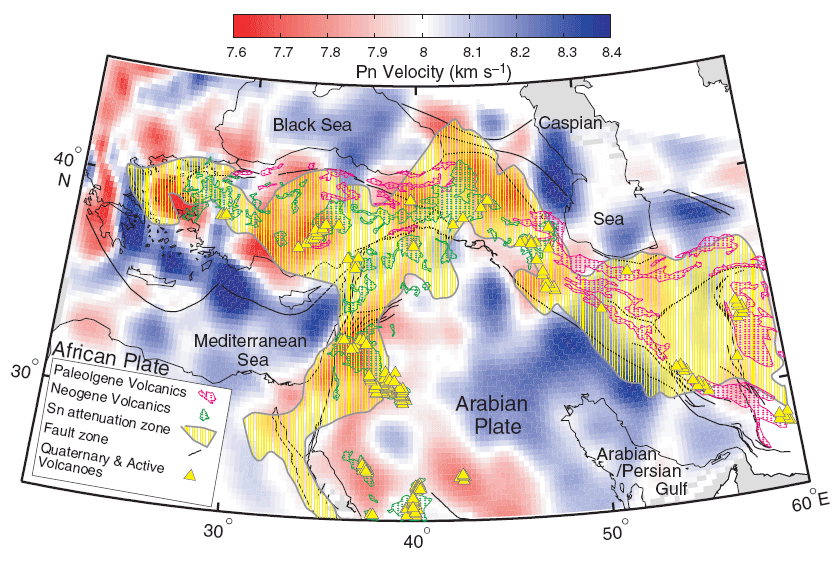
The interaction of the Arabian plate with the Eurasian plate has played a major role in building the young mountain belts along the Zagros–Bitlis continent–continent collision zone. Arabia’s northward motion is considered to be the primary driving force behind the present-day westerly escape of the Anatolian plate along the North and East Anatolian fault zones as well as the formation of the Turkish and the Iranian plateaux. In this study we mapped Pn-wave velocity and anisotropy structures at the junction of the Arabian, Eurasian and African plates in order to elucidate the upper-mantle dynamics in this region. Pn is a wave that propagates within the mantle lid of the lithosphere and is often used to infer the rheology and fabric of the mantle lithosphere. Applying strict selection criteria, we used arrival times of 166 000 Pn phases to invert for velocity and anisotropy in the region. Using a least-squares tomographic code, these data were analyzed to solve simultaneously for both velocity and azimuthal anisotropy in the mantle lithosphere.
We found that most of the continental regions in our study area are underlain
by low Pn velocity structures. Broad-scale (~500 km) zones of low (<8 km
s-1) Pn velocity anomalies underlie the Anatolian plate, the Anatolian plateau,
the Caucasus region, northwestern Iran and northwestern Arabia, and smaller
scale (~200 km), very low (<7.8 km s-1) Pn velocity zones underlie southern
Syria, the Lesser Caucasus, the Isparta Angle, central Turkey and the northern
Aegean Sea. The broad-scale low-velocity regions are interpreted to be hot and
unstable mantle lid zones, whereas very low Pn velocity zones are interpreted
to be regions of no mantle lid. The low and very low Pn velocity zones in eastern
Turkey, northwestern Iran and the Caucasus region may be associated with the
latest stage of intense volcanism that has been active since the Late Miocene.
The low Pn velocity zones beneath the Anatolian plate, eastern Turkey and northwestern
Iran may in part be a result of the subducted Tethyan oceanic
lithosphere beneath Eurasia. We also found a major low-velocity zone beneath
northwestern Arabia and the Dead Sea fault system. We interpret this anomaly
to be a possible extension of the hot and anomalous upper mantle of the Red
Sea and East Africa rift system. High Pn velocities (8.1–8.4 km s-1) are
observed to underlie the Mediterranean Sea, the Black Sea, the Caspian Sea,
and the central and eastern Arabian plate. Observed Pn anisotropy showed a higher
degree of lateral variation than did the Pn velocity structure. Although the
Pn anisotropy varies even in a given tectonic region, in eastern Anatolia very
low Pn velocity and Pn anisotropy structures appear to be coherent.
Click here to view a PDF of the post-print
This paper was published in Geophysical Journal International by Blackwell Publishing. Blackwell Publishing retains the copyright.
Copyright © 2004 Blackwell Publishing
Figure 11.
A comparative map showing Pn velocity with anisotropy (base map, red–blue colour, see Fig. 7a in reference), volcanic outcrops as green and pink polygons filled with plus signs, Sn attenuation zones as yellow hatched areas enclosed by a solid grey line (after Khaled Al-Damegh, personal communication), and volcanoes as yellow triangles. (See Fig. 1 in reference for geographic locations.)
